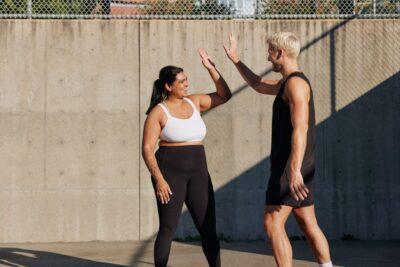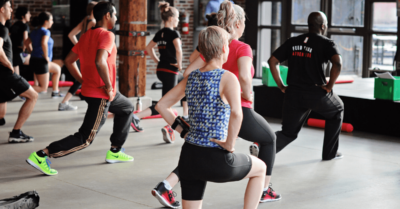With the coronavirus continuing to dominate the media, it’s safe to say we’re ready for 2022. As we all look to a brighter, healthier future, now is a good time to reflect on 2021. It’s no secret that gym owners have had to face some tough decisions in the face of a pandemic. Those that can adapt and shake off the fear of uncertainty will continue to drive forward.
As always, changing consumer behaviors are a key driver in the fitness industry. Thanks to advances in technology, an increase in health awareness, and digital fitness becoming utterly mainstream, the start of the New Year is a great time to assess the last year and look forward to 2022.
In this article, we try to understand the state of the fitness industry, how consumers feel about their own well-being, and twelve gym facts you need to know for 2022.
Skip ahead to:
- What’s next for the fitness industry?
- What are the biggest challenges for gym owners?
- 12 gym and fitness facts you need to know for 2022
What’s next for the fitness industry?
Hybrid gyms, shorter workouts, and fitness wearables have all been a hit this year and look set to grow. With online fitness classes and on-demand workouts helping members to stay accountable at home and outside of the gym, hybrid looks set to stay.
The Covid-19 crisis was a reality check for many to re-evaluate their own health and fitness. Government messaging surrounding daily exercise and the need to be healthy in the wake of a pandemic impacted public health awareness. Fitness isn’t just about moving your body anymore, it’s about exercising your body so that you can be as healthy as possible.
With months of isolation for many, mental health is in the spotlight at the moment and that will only continue. Mental health is being talked about more than ever before. Fitness studios have a role to play in supporting mental health by creating communities or hubs within their business to motivate and support gym members in the coming months. Creating a safe space to work out and open communication will continue to be essential for the member relationship.
As we look to the future of the fitness industry or any industry for that matter, technology will be a main player. Holistic wellness is intertwined within the fitness industry and technology can empower consumers to make decisions that directly impact their health and fitness. The pandemic certainly pressed fast forward on digital adoption. As more AI-enabled activity trackers come to the market, consumers will receive more accurate and effective insights. In a market that is so saturated, the key to attracting new customers in fitness is likely coming to the table with something new that adds another dimension to fitness.
When it comes to smart home gym equipment, often the biggest barrier for most people is price. An all singing and dancing smart home bike can set you back thousands, which isn’t viable for many. As more brands come to the market with competitive offerings, we could see more affordable options in connected fitness equipment. For example, the Tempo Move comes in at just under $400 for a connected home fitness product.
What are the biggest challenges for gym owners?
While there’s a huge opportunity in the fitness industry for gym owners and fitness trainers to enter the digital market, that comes with its own challenges. With 72% of fitness studios offering on-demand and live group workouts from 25% in 2019, it’s clear that hybrid model adoption has accelerated massively. A huge increase in market saturation for fitness apps and virtual fitness platforms means that brands need to go above and beyond to really stand out. In terms of branding and digital user experience, gym owners face growing competition.
Ultimately, fitness consumers will have an elevated expectation of your digital fitness offering from an increase in exposure. There will be higher standards put on digital fitness platforms, streaming, and on-demand fitness subscriptions. To remain competitive, fitness businesses will need to invest in equipment and technical know-how to create an exceptional digital experience.
With social media platforms like TikTok, Snapchat, and Instagram showcasing short bursts of information in snappy videos. How can fitness businesses market their businesses in a world of decreasing digital attention span? The internet is vast and exposure to content is intense. Keeping the attention span of your customers and target audience is difficult. As more businesses tap into using short-form videos, there’s an opportunity to enhance your 2022 marketing strategy.
The future is hybrid
In a post-pandemic world, almost every industry will feel the heat to go hybrid. The expectation of delivering a service or product in a virtual dimension is only growing. Hybrid fitness is one of the top fitness trends of 2022 and it will be interesting to see where this year takes us. We’re not only seeing this in gyms and fitness studios but how many companies are working. Whether it’s called flexible working or working from home for a few days a week, many businesses are creating hybrid settings.
The combination of live classes and facilities with online workouts and on-demand content takes into account the need for convenience and flexibility. Live classes continue to be a major part of member attraction in the first place, but online workouts can be a valuable retention tool.
12 gym and fitness facts you need to know for 2022
With the New Year fast approaching, it’s the perfect time to look at some of the top gym and fitness facts you need to know for 2022. From the most common reason for skipping the gym to the top workout booked this year, here are some key insights into health and fitness to help guide your business.
The Customer
Engagement Playbook
for Your Fitness
Business
Discover more 1. Young space-strapped people are driving gym membership numbers
After gyms reopened, the UK gym operator, Gym Group, experienced a jump in memberships. Interestingly, over two-thirds of its members are under the age of 34. The brand has noticed an increase in young members who are strapped for space. They don’t have large houses with home gyms, instead, they house share or live in small flats in bigger cities. A physical gym or fitness studio is important for those who don’t have the space. The chain aims to open another 40 new sites in 2022. This shows how gyms are growing at this time and seeing a shift in member demographics, due to the changing pandemic situation.
2. Several major gym chains filed for bankruptcy in 2020
The pandemic has been tough on several brands. Major fitness brands like Gold’s Gym, 24 Hour Fitness, Flywheel Sports, and Town Sports International have all filed for bankruptcy. While filing for bankruptcy isn’t necessarily a death sentence, it does show the impact of the pandemic on the fitness industry. 24 Hour Fitness permanently closed 100 of its 400 gyms and emerged from bankruptcy with an optimized cost structure. Flywheel Sports had to lay off 1,200 employees and the company closed its 42 studios at the time of filing.
3. The most common reason to skip the gym is a lack of time
One of the most common reasons for skipping the gym is simply a lack of time. With busy lives, work, and family commitments, sometimes exercise goes on the back burner. With this in mind, it’s a good idea to think about how you can support your time-strapped members by making exercise as convenient as possible. When members have the option to either go to the gym or take on an online class when they’re very busy, you can begin to combat one of the most common excuses for skipping the gym.
4. The US gym industry makes about $35 billion in revenue every year
In 2019, the US fitness industry hit an all-time high of $35 billion in revenue. Then, the pandemic struck. The IHRSA estimates that the industry lost just over $20 billion in 2020. While the industry experienced a big decline in 2020, it’s projected to rebound by the end of the year. Looking forward to 2022, the fitness industry as a whole is expected to grow by 171.75% by 2028.
5. The virtual fitness market is projected to reach almost $60 million by 2027
The virtual fitness market continues to be in the spotlight with estimates it could reach almost $60 million by 2027. As convenient wellness and fitness digital services continue to expand, advances in technology drive the market forward. It’s safe to say that the virtual fitness market is an exciting space to watch. You work out when you want with digital fitness and that’s very attractive.
6. As of July 2021, 22% of US gyms have permanently closed
According to the IHRSA, 22% of US gyms have permanently closed and 1.5 million people lost their jobs since the pandemic. While some gyms have seen unprecedented success, others remain at risk. Some businesses would not survive without financial aid and relief from the government. The fitness industry is a key part of the health and fitness of the nation.
7. Only 23.3% of American adults meet physical activity guidelines
The CDC recommends that adults should get at least 150 minutes of moderate aerobic exercise a week and include strength training exercises twice a week to build up and maintain muscle. Being physically active improves health, anxiety, and reduces the risk of several conditions including heart disease.
Only 23.3% of American adults meet physical activity guidelines for both aerobic exercise and strength training. Finding a way to encourage more people to work out, increase muscle mass, and improve their overall health is essential in the fitness industry. Whether it’s to hit their weight loss or fitness goal, build muscle, or lower blood pressure, exercise has an important role to play in health.
8. Working out in a group can improve athletic performance
There’s a reason that group fitness always makes it to some of the top fitness trends and most popular workout routines year on year. That’s because working out in a group has proven health benefits on performance and motivation. Group exercise can also improve quality of life and reduce stress more so than in people who work out alone. From weight lifting and body weight exercise routines to HIIT classes for fat loss, there’s such a huge variety of group fitness opportunities.
9. More people are exercising outdoors
Multiple lockdowns have changed the way many people look at nature and being outdoors. The Covid-19 crisis has fuelled a surge in exercising outdoors. Whether it’s running, hiking, bootcamps, outdoor personal training, or any form of exercise, being outdoors and exercising at the same time offers a dual benefit. Research highlights the importance of exercise and being outdoors for anxiety and depression.
10. Exercise plays a key role in mental health
A recent report shows that exercise plays a key role in mental health and well-being. The top three types of workouts for mental health are general physical activity, cardiovascular, and yoga. With this in mind, you can think about how you can maximize the fitness experience, community, and culture to encourage adherence to benefit overall wellness and support a healthy lifestyle.
11. ClassPass rank dance as top 10 most booked workout activities
For the first time in ClassPass history, dance ranked as one of the top 10 most booked activities. Some of the top dance styles include cardio dance, pole dance, hip hop, Zumba, and ballet. Dance workouts tend to be associated with high energy, fun, and music to release plenty of endorphins. This could be a sign that more people are looking to enjoy their workouts and get more out of them than simply exercising or hitting the treadmill.
12. 70% of professionals drop by fitness studios on working from home days
Another interesting statistic from ClassPass is that over 70% of professionals are now heading to fitness studios on the days they work from home. Rather than dropping by the gym or studio on the way back from work, it seems that people are more likely to try out a new fitness studio when working from home.
In summary
Moving forward, no doubt the pandemic will continue to fill the news. But it’s clear that regular exercise has a big role to play in the health, happiness, and well-being of many people. As virtual fitness expands and the need for convenient and flexible fitness services increases, 2022 looks set to be an exciting year for the industry.














